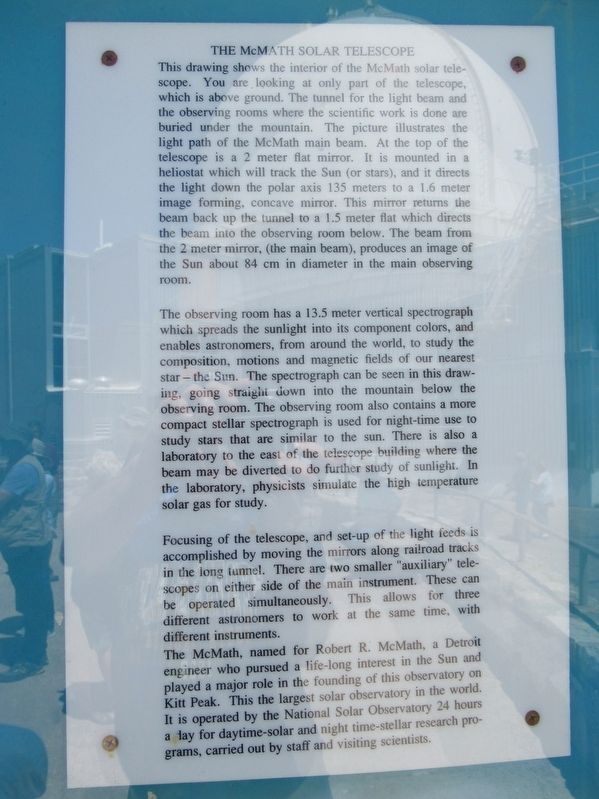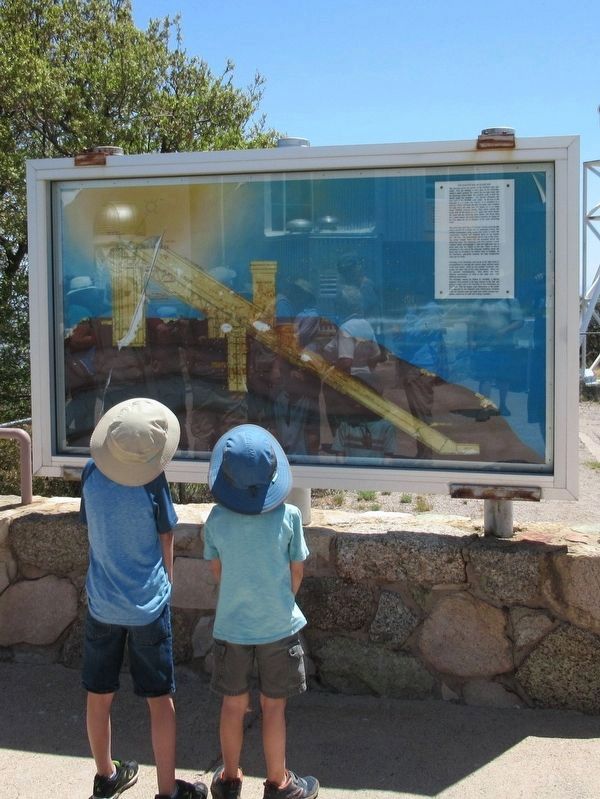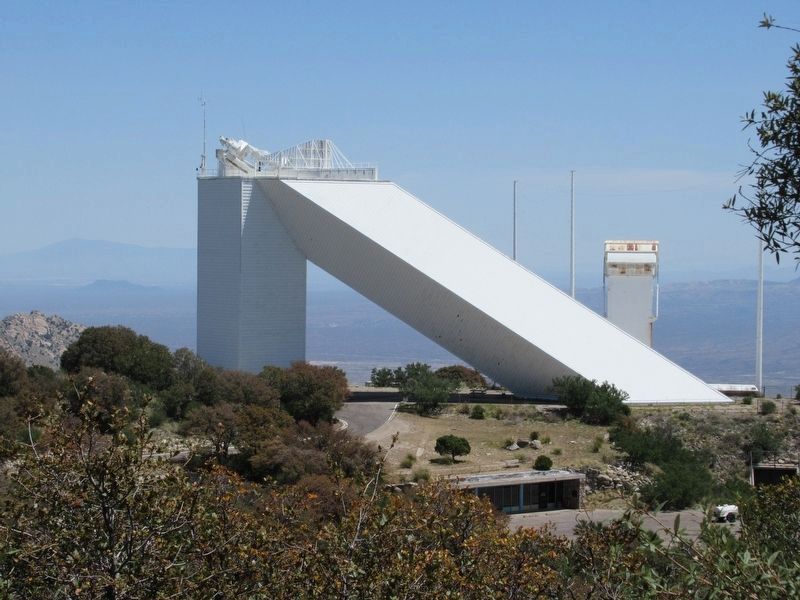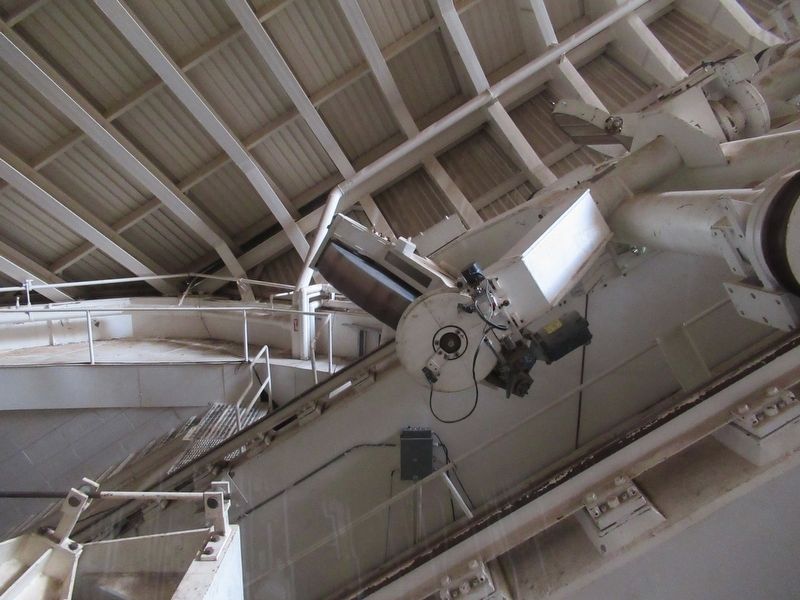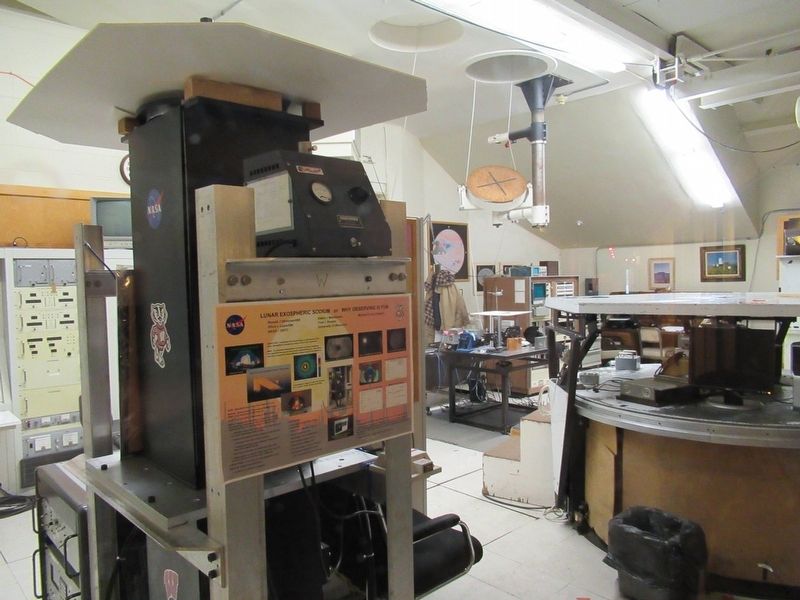Kitt Peak in Tucson in Pima County, Arizona — The American Mountains (Southwest)
The McMath Solar Telescope
This drawing shows the interior of the McMath solar telescope. You are looking at only part of telescope which is above ground. The tunnel for the light beam and the observing rooms where the scientific work is done are buried under the mountain. The picture illustrates the light path of the McMath main beam. At the top of the telescope is a 2 meter flat mirror. It is mounted in heliostat which will track the Sun (or stars), and it directs the light down the polar axis 135 meters to a 1.6 meter image forming, concave mirror. This mirror returns the beam back up the tunnel to a 1.5 meter flat which directs the beam into the observing room below. The beam from the 2 meter mirror, (the main beam), produces an image of the Sun about 84 cm in diameter in the main observing room.
The observing room has a 13.5 meter vertical spectrograph which spreads the sunlight into its component colors, and enables astronomers, from around the world, to study the composition, motions and magnetic fields of our nearest star – the Sun. The spectrograph can be seen in this drawing, going straight down into the mountain below the observing room. The observing room also contains a more compact stellar spectrograph is used for night-time use to study stars that are similar to the sun. There is also a laboratory to the east of the telescope building where the beam may be diverted to do further study of sunlight. In the laboratory, physicists simulate the high temperature solar gas for study.
Focusing of the telescope, and set-up of the light feeds is accomplished by moving the mirrors along railroad tracks in the long tunnel. There are two smaller "auxiliary" telescopes on either side of the main instrument. These can be operated simultaneously. This allows for three different astronomers to work at the same time, with different instruments.
The McMath, named for Robert R. McMath, a Detroit engineer who pursued a life-long interest in the Sun and this observatory on played a major role in the founding of this observatory on Kitt Peak. This the largest solar observatory in the world. It is operated by the National Solar Observatory 24 hours a day for daytime-solar and night time-stellar research programs, carried out by staff and visiting scientists.
Topics. This historical marker is listed in this topic list: Science & Medicine.
Location. 31° 57.479′ N, 111° 35.884′ W. Marker is in Tucson, Arizona, in Pima County. It is in Kitt Peak. Marker is on Arizona Route 386, 12 miles south of W. Tucson-Ajo Hwy. (Arizona Route 86), on the left when traveling south. Located at Kitt Peak National Observatory in the Tohono O'odham
Nation Reservation. Touch for map. Marker is at or near this postal address: 950 N Cherry Ave, Tucson AZ 85735, United States of America. Touch for directions.
Other nearby markers. At least 4 other markers are within walking distance of this marker. Kitt Peak National Observatory (about 400 feet away, measured in a direct line); The WIYN Observatory (about 600 feet away); The Vacuum Telescope (approx. 0.2 miles away); Steward Observatory (approx. 0.3 miles away).
More about this marker. The marker is located next to the 2.1-meter telescope, about 200 yards from the Solar Telescope.
Also see . . .
1. Kitt Peak National Observatory. Wikipedia entry (Submitted on January 9, 2022, by Larry Gertner of New York, New York.)
2. National Solar Observatory. Website homepage (Submitted on April 18, 2017, by Michael Herrick of Southbury, Connecticut.)
Credits. This page was last revised on December 2, 2023. It was originally submitted on April 18, 2017, by Michael Herrick of Southbury, Connecticut. This page has been viewed 258 times since then and 7 times this year. Photos: 1, 2, 3, 4, 5. submitted on April 18, 2017, by Michael Herrick of Southbury, Connecticut.
